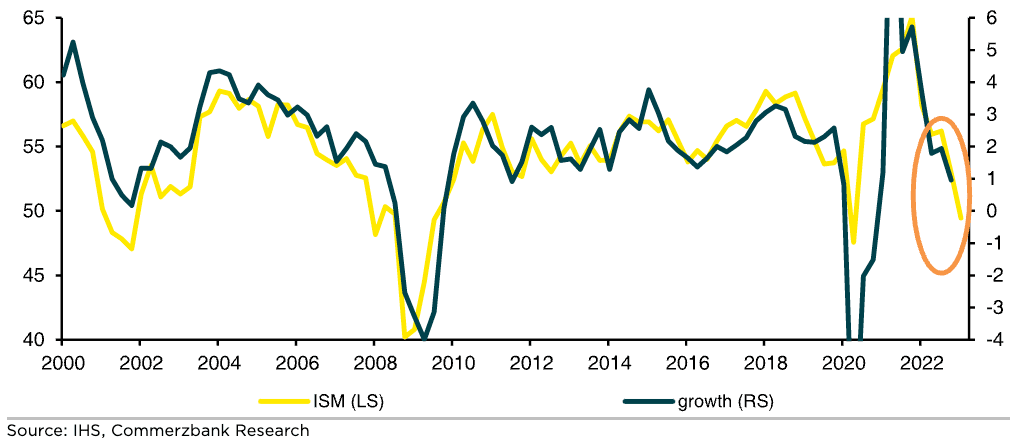U.S. Growth Slowdown Likely in Q1, Presenting USD Weakness
- Written by: Gary Howes
-

Image © Adobe Images
U.S. economic growth data for the final quarter of 2022 was surprisingly strong, but economists say all signs point to a material slowdown over the coming weeks, which should keep the Dollar pressured.
The U.S. economy grew at a 2.9% annualised pace in the fourth quarter of 2022 which was faster than the 2.6% expected by the consensus.
The data prompted an initial knee-jerk rise in the Dollar on the basis that some traders believed this was a sign the Federal Reserve would have to reconsider slowing down its interest rate hiking cycle.
This is because a strong economy is consistent with inflationary pressures as wages rise and firms can charge more given elevated demand.
But the Dollar soon reversed direction as relevant details of the U.S. economic reading show much of the recent growth came as companies continued to boost their inventories following the shortages that followed the post-Covid supply chain issues.
The figures also revealed business investment has cooled significantly as the impact of Federal Reserve rate hikes makes an impact.
The GDP data is therefore backwards looking and the clues they do offer about the future don't contradict more timely economic surveys that suggest an economic slowdown beckons.
"Growth likely will be much weaker in Q1; we are pencilling in a -2% headline, as the inventory valuation boost partly reverses and consumption softens," says Ian Shepherdson, Chief Economist at Pantheon Macroeconomics.
The Pound to Dollar exchange rate dipped to 1.2361 in reaction to the data but recovered back to 1.2415 as investors discounted the more relevant elements of the GDP report that suggests the Federal Reserve can afford to consider an end to its rate hiking cycle.
"With inventories now elevated across many industries, and consumers running through excess savings, we see the potential for a contraction in the economy in the first quarter as the impact of past rate hikes materializes more fully, and consistent with a tapering off of momentum in recent monthly indicators," says Katherine Judge, Senior Economist at CIBC Capital Markets.
Dr. Christoph Balz, Senior Economist at Commerzbank says some "hard" December data such as retail sales and industrial production were already very weak, which could be a sign that the economy is noticeably losing momentum.
"This is likely to be the last strong quarter for a while, especially as the details are already not quite so encouraging. We still expect the economy to slide into recession due to the Fed's massive rate hikes," says Balz.
The more timely PMI survey data from the ISM signals a sharp slowdown in economic activity is likely.
Assuming that the ISM indices remain at the low December level in the first quarter, the year-on-year rate of GDP growth should tend toward zero in the first quarter, shows Commerzbank's research.
"A rate hike by 'only' 25bp at the next Fed meeting is now increasingly likely following numerous comments of Fed officials along these lines," says Esther Reichelt, FX Analyst at Commerzbank.
"As long as everything continues to point towards a recession, the market is unlikely to rethink its expectation of the Fed lowering interest rates again in the second half of the year, which constitutes the basis of the current dollar weakness," says Reichelt.
Next week's Federal Reserve policy decision forms the highlight of the Dollar's near-term calendar and comes amidst a spell of Dollar weakness that has seen it retreat against most major currencies.
Over the past month it has fallen against all its G10 peers, save for Norway's Krone.
This weakness has coincided with a rally in GBP/USD above 1.20 with highs at 1.2448 being tested in mid-December and again on January 23.
"With inflationary pressures easing and the global growth outlook improving, we no longer expect the US dollar to breach its late September peak," says Jonathan Petersen, a currency analyst at Capital Economics.
However, the outlook for the Dollar is not necessarily one that won't throw up surprises as any U.S. and global economic recession could boost its attractiveness.
One key pillar of Dollar strength in 2022 was the retreat in global equity markets which prompted investors to seek the safety of the highly liquid and easily accessible U.S. currency.
Should another bout of stock market weakness be triggered by a more severe economic deterioration, then the Dollar could rally.
So while the near-term outlook continues to favour Pound upside against the Dollar, the market could surprise at some point over the coming weeks.






